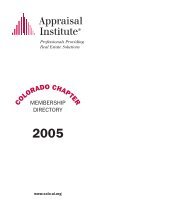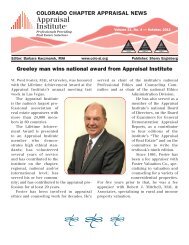June2005 - Colorado Appraisal Institute
June2005 - Colorado Appraisal Institute
June2005 - Colorado Appraisal Institute
You also want an ePaper? Increase the reach of your titles
YUMPU automatically turns print PDFs into web optimized ePapers that Google loves.
EDITORIAL<br />
RAMBLINGS<br />
by Martin W. Ward, MAI, SRA<br />
THROUGH A CRYSTAL BALL, DARKLY<br />
As we all know, the premise of value, market value or<br />
other definitions, is essentially what the market perceives<br />
is the present value of future benefits of ownership<br />
of real estate. In income properties, this is reflected<br />
in anticipated future income, but in owner-occupied<br />
properties, including residential properties, the benefits<br />
are often not income but the use of the property, the<br />
desire to live in a certain neighborhood, or other intangible<br />
future benefits. As business men and women, the<br />
value of our business operations is based on our ability<br />
to foresee what the future holds for our profession. And<br />
in the current changing technological times, the ability<br />
to look into the crystal ball and see our future, always<br />
somewhat murky, is becoming even harder.<br />
In the March 2005 issue of The <strong>Colorado</strong> Mortgage<br />
Press there were two articles that discussed issues<br />
relating to our future business practices. While not<br />
directly related, they do, in fact, have something in<br />
common if you think about them and make some<br />
casual links.<br />
In the first, Charles W. Elliott, MAI, SRA of Greensboro,<br />
North Carolina, asks the question “Will Technology<br />
Replace Appraisers?” The question is, of course,<br />
regarding Automated Valuation Models (AVMs) – and<br />
would someone please hold Matt George, SRA down<br />
here – and the trend for the use of these statistical<br />
models as the basis for underwriting mortgage loans.<br />
Current estimates are that 15 to 20 percent of all first<br />
mortgages are made based on AVMs, and that 50 percent<br />
of all equity loans use AVMs to support value.<br />
While the trend to AVMs may be a tide we are trying to<br />
hold back with a dike we can’t plug using only our fingers,<br />
we can help our clients in understanding where<br />
AVMs have bigger problems. Examples include areas<br />
in which there are limited sales transactions, or where<br />
properties are not particularly homogenous, such as<br />
rural areas or resort areas. In addition, in markets with<br />
upward or downward trends in values the AVM method<br />
will frequently over value or under value a property<br />
since the historical sales data will not best reflect the<br />
current state of the market. In other words, if the statistical<br />
model is not properly set up, the shortcomings<br />
of the AVM method will result in a lower value than an<br />
independent appraisal may conclude, resulting in a<br />
lower loan amount, or in markets where values are<br />
declining, it would result in too high a loan being made.<br />
The second article is by Patrick J. Butler of Montgomery,<br />
Illinois and is titled “Limiting <strong>Appraisal</strong><br />
Liability.” No, this article is not a useful article for<br />
Page 4<br />
appraisers on how to limit liability for their appraisals,<br />
but for mortgage brokers on limiting their appraisal<br />
liability. This article deals with regulations regarding<br />
the attempt to influence appraised values. Apparently,<br />
Choice One Mortgage in Illinois was fined $5,000 in<br />
2004 by the Illinois Department of Financial and<br />
Professional Regulation because they tried to influence<br />
appraised values of loans they were making. While we<br />
do not have similar regulations in <strong>Colorado</strong> that I am<br />
aware of, some of the violations stated in the fine sound<br />
familiar, including:<br />
- Ordering appraisals “with the minimum value necessary<br />
to complete the loan…”<br />
- Writing down the owner’s estimate of value on the<br />
order form.<br />
- Requesting “comp checks” from appraisers. This<br />
was found to be a problem since the effort by the<br />
appraiser to choose which comparables to provide<br />
the lender will require the appraiser to complete<br />
enough research that the result would be considered<br />
an oral appraisal report, and thus require an<br />
appraiser to complete a work file that provides support<br />
for their “report”. This affects both appraisers,<br />
who are obliged to complete a work file, and the brokers,<br />
who if they are engaging appraisers they know<br />
are not completing and documenting their work<br />
files, result in the broker having made a decision<br />
based on an undocumented appraisal.<br />
I found it interesting that in this article it is also<br />
noted that only challenging values the broker considers<br />
low can show a bias by the broker to influence<br />
appraisers upward. The article recommended having a<br />
process that creates an unbiased system for challenging<br />
appraisals, both for being too high or too low.<br />
How do these two stories relate? If you think about<br />
it, the second article is all about the attempts by mortgage<br />
brokers – which could also be true of other users<br />
of appraisal services – to influence our process. Just<br />
imagine what could happen if unscrupulous users of<br />
appraisal services were allowed to influence the statistical<br />
models that result in AVMs.<br />
While the trend may be toward more limited appraisal<br />
services, I believe the long-term prospects for appraisal<br />
services are still good for providers of quality and diversified<br />
appraisal services. As markets go through natural<br />
expansions and contractions, appraisals by appraisers<br />
will still be important and necessary. The attention span<br />
of Americans is famously short having already forgotten<br />
the problems created by the savings and loan debacle of<br />
the 1980s, and the importance of good quality appraisal<br />
services. Eventually, the market will change due to a<br />
contraction or high level of foreclosures, and the need for<br />
appraisal services will again be acknowledged. The key<br />
will be to survive during times that appraisal services are<br />
less appreciated by our clients. The best method to do<br />
this is to diversify your practice beyond mortgage work.<br />
At least that is what my crystal ball sees, however<br />
murky it may be. I really need to get this thing cleaned<br />
and polished.





